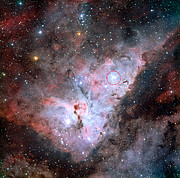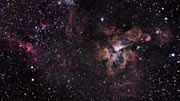Press Release
Stellar Family Portrait Takes Imaging Technique to New Extremes
3 December 2009
The young star cluster Trumpler 14 is revealed in another stunning ESO image. The amount of exquisite detail seen in this portrait, which beautifully reveals the life of a large family of stars, is due to the Multi-conjugate Adaptive optics Demonstrator (MAD) on ESO’s Very Large Telescope. Never before has such a large patch of sky been imaged using adaptive optics [1], a technique by which astronomers are able to remove most of the atmosphere's blurring effects.
Noted for harbouring Eta Carinae — one of the wildest and most massive stars in our galaxy — the impressive Carina Nebula also houses a handful of massive clusters of young stars. The youngest of these stellar families is the Trumpler 14 star cluster, which is less than one million years old — a blink of an eye in the Universe’s history. This large open cluster is located some 8000 light-years away towards the constellation of Carina (the Keel).
A team of astronomers, led by Hugues Sana, acquired astounding images of the central part of Trumpler 14 using the Multi-conjugate Adaptive optics Demonstrator (MAD, [2]) mounted on ESO’s Very Large Telescope (VLT). Thanks to MAD, astronomers were able to remove most of the blurring effects of the atmosphere and thus obtain very sharp images. MAD performs this correction over a much larger patch of the sky than any other current adaptive optics instrument, allowing astronomers to make wider, crystal-clear images.
Thanks to the high quality of the MAD images, the team of astronomers could obtain a very nice family portrait. They found that Trumpler 14 is not only the youngest — with a refined, newly estimated age of just 500 000 years — but also one of the most populous star clusters within the nebula. The astronomers counted about 2000 stars in their image, spanning the whole range from less than one tenth up to a factor of several tens of times the mass of our own Sun. And this in a region which is only about six light-years across, that is, less than twice the distance between the Sun and its closest stellar neighbour!
The most prominent star is the supergiant HD 93129A, one of the most luminous stars in the Galaxy. This titan has an estimated mass of about 80 times that of the Sun and is approximately two and a half million times brighter! It makes a stellar couple — a binary star — with another bright, massive star. The astronomers found that massive stars tend to pair up more often than less massive stars, and preferably with other more massive stars.
The Trumpler 14 cluster is undoubtedly a remarkable sight to observe: this dazzling patch of sky contains several white-blue, hot, massive stars, whose fierce ultraviolet light and stellar winds are blazing and heating up the surrounding dust and gas. Such massive stars rapidly burn their vast hydrogen supplies — the more massive the star, the shorter its lifespan. These giants will end their brief lives dramatically in convulsive explosions called supernovae, just a few million years from now.
A few orange stars are apparently scattered through Trumpler 14, in charming contrast to their bluish neighbours. These orange stars are in fact stars located behind Trumpler 14. Their reddened colour is due to absorption of blue light in the vast veils of dust and gas in the cloud.
The technology used in MAD to correct for the effect of the Earth’s atmosphere over large areas of sky will play a crucial role in the success of the next generation European Extremely Large Telescope (E-ELT).
Notes
[1] Telescopes on the ground suffer from a blurring effect introduced by atmospheric turbulence. This turbulence causes the stars to twinkle in a way that delights poets but frustrates astronomers, since it smears out the fine details of the images. However, with adaptive optics techniques, this major drawback can be overcome so that the telescope produces images that are as sharp as theoretically possible, i.e. approaching conditions in space. Adaptive optics systems work by means of a computer-controlled deformable mirror that counteracts the image distortion introduced by atmospheric turbulence. It is based on real-time optical corrections computed at very high speed (several hundreds of times each second) from image data obtained by a wavefront sensor (a special camera) that monitors light from a reference star.
[2] Present adaptive optics systems can only correct the effect of atmospheric turbulence in a very small region of the sky — typically 15 arcseconds or less — the correction degrading very quickly when moving away from the reference star. Engineers have therefore developed new techniques to overcome this limitation, one of which is multi-conjugate adaptive optics. MAD uses up to three stars instead of one as references to remove the blur caused by atmospheric turbulence over a field of view thirty times larger than that available to existing techniques (eso0719).
More information
This research has been presented in a paper submitted to Astronomy and Astrophysics (“A MAD view of Trumpler 14”, by H. Sana et al.).
The team is composed of H. Sana, Y. Momany, M. Gieles, G. Carraro, Y. Beletsky, V. Ivanov, G. De Silva and G. James (ESO). H. Sana is now working at the Amsterdam University, The Netherlands.
ESO, the European Southern Observatory, is the foremost intergovernmental astronomy organisation in Europe and the world’s most productive astronomical observatory. It is supported by 14 countries: Austria, Belgium, Czechia, Denmark, France, Finland, Germany, Italy, the Netherlands, Portugal, Spain, Sweden, Switzerland and the United Kingdom. ESO carries out an ambitious programme focused on the design, construction and operation of powerful ground-based observing facilities enabling astronomers to make important scientific discoveries. ESO also plays a leading role in promoting and organising cooperation in astronomical research. ESO operates three unique world-class observing sites in Chile: La Silla, Paranal and Chajnantor. At Paranal, ESO operates the Very Large Telescope, the world’s most advanced visible-light astronomical observatory. ESO is the European partner of a revolutionary astronomical telescope ALMA, the largest astronomical project in existence. ESO is currently planning a 42-metre European Extremely Large optical/near-infrared Telescope, the E-ELT, which will become “the world’s biggest eye on the sky”.
Links
- More info: adaptive optics public web page
- Research paper
Contacts
Hugues Sana
Amsterdam University
The Netherlands
Tel: +31 20 525 8496
Email: H.Sana@uva.nl
Yuri Beletsky
ESO
Chile
Tel: +56 5543 5311
Email: ybialets@eso.org
Enrico Marchetti
ESO
Garching
Tel: +49 89 3200 6458
Email: emarchet@eso.org
About the Release
| Release No.: | eso0947 |
| Legacy ID: | PR 47/09 |
| Name: | Trumpler 14 |
| Type: | Milky Way : Star : Grouping : Cluster : Open |
| Facility: | Very Large Telescope |
| Instruments: | ESO Multi-conjugate Adaptive optics Demonstrator (MAD) |
| Science data: | 2010A&A...515A..26S |



